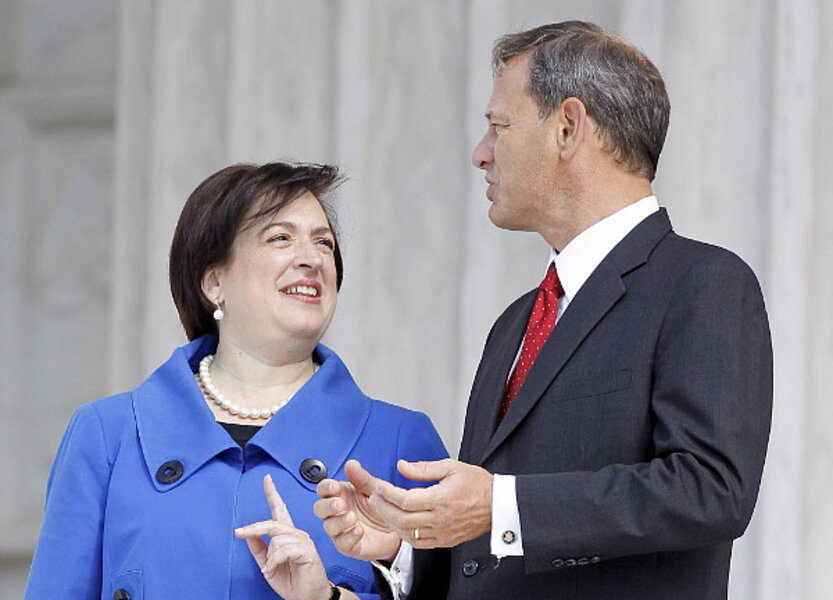US Supreme Court opens with historic changes
Loading...
| Washington
Offensive protests at military funerals, a ban on the sale of violent video games to minors, and an effort in Arizona to police the hiring of illegal immigrants are among the top cases confronting the US Supreme Court in its 2010-2011 term.
The high court’s new term, which begins Monday and runs through June, is also notable because it will provide the first genuine insight into what kind of justice Elena Kagan will become. Ms. Kagan won Senate confirmation in August to replace retired Justice John Paul Stevens.
The Supreme Court is in the midst of a significant transformation after eleven years with the same lineup of justices. Since 2005, four new members have joined the court, two on the conservative side and two on the liberal side.
The recent arrival of Kagan brings a heightened sense of expectation to the term with historic change taking root. Three of the nine justices now are women.
At the same time there is an air of uncertainty. This is the first time in 35 years the Supreme Court begins its work without Justice Stevens on the bench.
“No one who is sitting on the court has ever sat without Stevens as a colleague,” Washington lawyer Jerrold Ganzfried told a briefing at the Washington Legal Foundation. “That is going to be a big change.”
Justice Kennedy still the potential tie-breaker
Legal analysts say the new lineup of justices will maintain the 4 to 4 liberal-conservative balance of power that has existed for years, with Justice Anthony Kennedy providing the potential tie-breaking swing vote.
But there are also more subtle influences in play. Chief Justice John Roberts appears to be making an effort to unify the court when possible, somewhat undercutting Kennedy’s power as the swing justice.
At the same time, the retirement of Stevens this year elevates Kennedy to the third most senior justice – behind Chief Justice Roberts and Justice Antonin Scalia, both conservatives. Kennedy’s new seniority potentially makes him the most senior justice in cases where he swings to the liberal side.
Under court tradition, the most senior justice on the majority side of a case has the authority to assign who writes the opinion. Legal analysts will be watching to see if this becomes a factor in how often Kennedy casts a swing vote and delivers a liberal victory.
Another potential development to watch, analysts say, will be who fills Stevens’ role as the long-time leader of the court’s liberal wing. Stevens’ experience and gentle, respectful manner helped maintain an important behind-the-scenes dynamic at the court.
Court watchers suggest Kagan, the former solicitor general and dean of Harvard Law School, may be particularly well suited for the role. Her liberal supporters are hoping for much more. They see her emerging as a liberal counterforce to the conservative’s superstar on the high court – Justice Scalia.
George Washington University law professor Jeffrey Rosen told a recent gathering of the Federalist Society that liberal expectations for Kagan’s tenure on the high court are boundless.
“Will she fulfill liberal hopes that she is the Messiah?” he asked.
Despite months of inquiry and investigation prior to her confirmation, Kagan takes the bench as something of a stealth justice.
With no prior judicial experience and thus no paper trail of opinions suggesting how she might vote in future cases, Justice Kagan’s every action and utterance will be noted, parsed, and analyzed with an eye toward building the kind of predictive portrait that never emerged from her Senate confirmation hearings.
As a scholar, Kagan often focused on First Amendment issues. But even that work isn’t helpful in forecasting how she might vote in an actual case.
“You can’t really tell from her writings where she is coming from on the First Amendment,” Washington lawyer Cliff Sloan told the American Constitution Society in a recent briefing. “It seems as though she has some pro-First Amendment inclinations, but it remains to be seen how that will be manifested.”
Kagan likely to vote with liberal wing
This much is clear: She is smart, funny, and knowledgeable in the law. It is expected she will vote with the court’s liberal wing. But analysts say they don’t have much more to go on.
Because her service as solicitor general included work on a large number of pending or potential Supreme Court cases, Kagan has announced she will recuse herself from consideration in almost half of the cases currently on the high court’s docket. Her absence will leave only eight justices to decide those cases. It could determine the outcome in some disputes or leave the court mired in a 4 to 4 tie.
In cases of a tie, the lower court decision is affirmed but no national precedent is established.
The Supreme Court has already agreed to hear 54 cases and will likely round out the docket by accepting 30 to 40 more appeals during the coming months.
In addition to the three cases already mentioned, the court’s case lineup features disputes that will help define the power of federal judges to address overcrowding in state prisons, the scope of personal privacy for individuals facing intrusive government background investigations, and whether corporations may invoke personal privacy protections to prevent the public release of corporate documents under the Freedom of Information Act.
The court will also decide whether federal law prevents a family from suing a drug maker for vaccine side effects that left a six-month-old developmentally disabled, whether offering tax credits for parochial school tuition violates the separation of church and state, and whether the government can use the state secrets privilege to prevent a defense contractor from defending itself from contract default charges.





